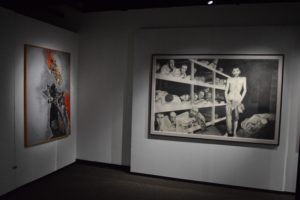By Sara McDonald
In the three years I’ve worked at the Florida Holocaust Museum, no exhibit on the second floor came close to the dynamic nature of Murray Zimiles’ explosive “The Holocaust and the Book of Fire.”
Zimiles, the stepson of a Holocaust survivor, felt compelled to create a collection of work that dealt with the Holocaust itself, as well as questioning the presence of civilization and the “absence of God during the Holocaust.”

The first piece of the exhibit is called “The Butcher,” and is unlike anything I have ever seen. It’s raw. It’s horrific. It’s loud and honest.
The piece features a man with greenish skin that, on first glance, looks like an estranged killer from a horror movie. He’s wearing a classic butcher white apron and staring straight at the viewer. In the background, hanging on meat hooks, are the headless carcasses of pigs and one human body.
Pigs resurface a lot throughout the exhibit. Why? Symbolism.
In the Jewish faith, a pig is not kosher and cannot be eaten. It is also fair to say that since the animal lives and spreads filth, it is commonly used as a symbol of corruption and hypocrisy.
Applying this concept in the context with works like “The Butcher,” it is easy to understand the metaphor sprinkled in the other gritty pieces of work. Nazi’s looked at Jewish people as swine, and saw them as the source of corruption and hypocrisy in their nation.
“The Holocaust and the Book of Fire” also uses historical symbolism, like the burning of synagogues on Kristallnacht.
In “Crystal Nact,” there is a synagogue burning in the background of the piece. Similar to the photograph in the permanent exhibit downstairs, that shows the destruction of a synagogue on Kristallnacht, the night this piece is inspired by.
Another piece, “Aktion, Poland 1938-1945,” portrays mass killing. In this chaotic scene, naked women are lined up, waiting to die. One of the women cradles her child.
This piece also mirrors the permanent exhibit downstairs, which features a woman holding her child’s head, aligned to her own. Behind her is a Nazi soldier, pointing a gun at her back, so that it would only take one bullet to take two lives.
These historical retellings are important because they bring you history through two different outlets: the photographs from the museum’s exhibit and the artist’s work — this isn’t just art, it’s real.
Part of the experience of this exhibit is to feel the authenticity of these events and emotions by making you feel like a part of the pieces.

The explosions are coming at you and people are running around you. The victims meet your eye, maybe making you a Nazi, or maybe making you another victim, but maybe it’s just a plea to learn from the past so we never repeat the future.
This is a brilliant exhibit, which is brought to our community by a nonprofit that cares about the basic human rights of everyone that is not only in our community but in our country, and in our world.
I hope that we can come together under the lessons of the past that this exhibit presents to us and the hope for the future that the Florida Holocaust Museum instills in us.
I invite you all to come and gain a new perspective on the importance of understanding the grittiness of the past so that we can embrace a world with a lot less hatred.



